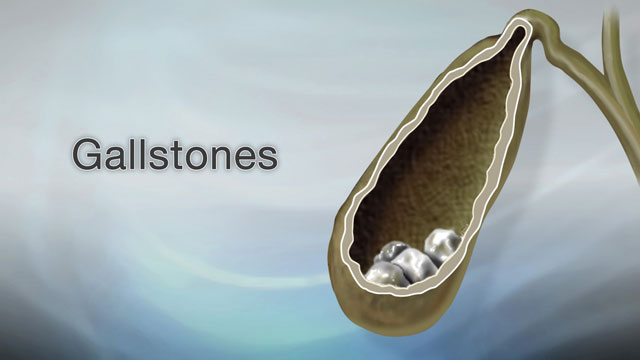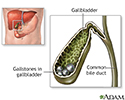Gallstones - discharge
Chronic cholecystitis - discharge; Dysfunctional gallbladder - discharge; Choledocholithiasis - discharge; Cholelithiasis - discharge; Acute cholecystitis; Cholangitis - discharge
You have gallstones. These are hard, pebble-like deposits that form inside your gallbladder.
Most gallstones do not cause symptoms. Sometimes gallstones cause intermittent pain that goes away on its own (biliary colic). This usually does not require hospitalization.
However, because your gallstones caused problems, you were admitted to the hospital. You may have been admitted for cholecystitis, which is inflammation of the gallbladder usually from gallstones getting blocked in the drainage tubes (bile ducts). You may also have been admitted for complications from this, such as infection in the drainage ducts (cholangitis) or gallstone-related pancreatitis. This article tells you how to take care of yourself when you leave the hospital.

When You're in the Hospital
You may have had an infection in your gallbladder. You may have received medicines to reduce the swelling and fight the infection. You may have had surgery to remove your gallbladder. This is called cholecystectomy. It is the most common treatment for gallstones that are causing problems or symptoms. There are two types of cholecystectomy procedures:
- Open cholecystectomy. This is performed when your gallbladder is scarred, inflamed, or infected.
- Laparoscopic cholecystectomy. This procedure is more common. It is less invasive and has a shorter recover period than open surgery.
If a gallstone is blocking a drainage duct outside of the gallbladder, then you may have had other procedures to remove those gallstones, but removing the gallbladder is usually done during the same hospital stay or the gallstone problems usually come back.
What to Expect at Home
You may continue to have pain and other symptoms if your gallstones return or were not removed. If you had a cholecystectomy, you will be given instructions to follow up after surgery.
Self-care
You may be on a liquid diet for some time to give your gallbladder a rest. When you are eating regular food again, avoid overeating. If you are overweight try to lose weight.
Take acetaminophen (Tylenol) for pain. Ask your health care provider about stronger pain medicines.
Take any medicines you have been given to fight infection the way you were told to. You may be able to take medicines that dissolve gallstones, but they may take 6 months to 2 years to work, and the gallstones return after stopping the medicine. So, this medicine is not used a lot. That's why if you have symptomatic gallstones, your gallbladder is removed.
When to Call the Doctor
Contact your provider if you have:
- Steady, severe pain in your upper belly
- Pain in your back, right shoulder, or between your shoulder blades that does not go away and is getting worse
- Nausea and vomiting
- Fever or chills
- Yellow color to your skin and the whites of your eyes (jaundice)
- Grey or chalky white bowel movements
References
Cameron J. Gallbladder and biliary tree. In: Cameron J, ed. Current Surgical Therapy. 14th ed. Philadelphia, PA: Elsevier; 2023:chap 8.
Fogel EL, Sherman S. Diseases of the gallbladder and bile ducts. In: Goldman L, Cooney KA, eds. Goldman-Cecil Medicine. 27th ed. Philadelphia, PA: Elsevier; 2024:chap 141.
Glasgow RE, Mulvihill SJ. Treatment of gallstone disease In: Feldman M, Friedman LS, Brandt LJ, eds. Sleisenger and Fordtran's Gastrointestinal and Liver Disease. 11th ed. Philadelphia, PA: Elsevier; 2021:chap 66.
Review Date: 10/30/2024




